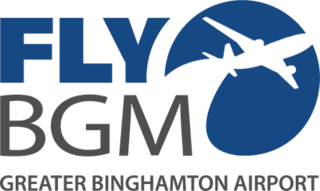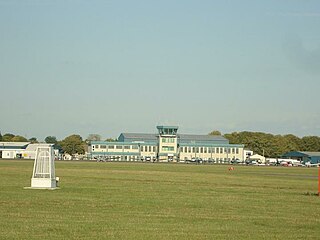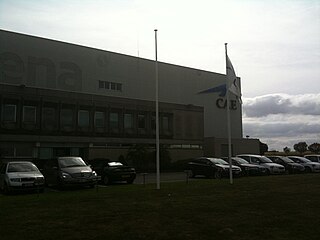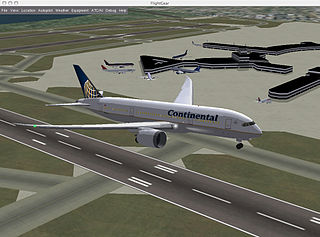Related Research Articles

A flight simulator is a device that artificially re-creates aircraft flight and the environment in which it flies, for pilot training, design, or other purposes. It includes replicating the equations that govern how aircraft fly, how they react to applications of flight controls, the effects of other aircraft systems, and how the aircraft reacts to external factors such as air density, turbulence, wind shear, cloud, precipitation, etc. Flight simulation is used for a variety of reasons, including flight training, the design and development of the aircraft itself, and research into aircraft characteristics and control handling qualities.

Microsoft Flight Simulator is a series of flight simulator programs for MS-DOS, Classic Mac OS and Microsoft Windows operating systems. It was an early product in the Microsoft application portfolio and differed significantly from Microsoft's other software, which was largely business-oriented. As of November 2022, Microsoft Flight Simulator is the longest-running software product line for Microsoft, predating Windows by three years. Microsoft Flight Simulator is one of the longest-running PC video game series of all time.

L3 Technologies, formerly L-3 Communications Holdings, was an American company that supplied command and control, communications, intelligence, surveillance and reconnaissance (C3ISR) systems and products, avionics, ocean products, training devices and services, instrumentation, aerospace, and navigation products. Its customers included the Department of Defense, Department of Homeland Security, United States Intelligence Community, NASA, aerospace contractors, and commercial telecommunications and wireless customers. In 2019, it merged with Harris Corporation to form L3Harris Technologies.

Related article: List of surviving Link Trainers

Greater Binghamton Airport is a county-owned American airport eight miles north of Binghamton, in Broome County, New York. It is in East Maine, New York and serves the Southern Tier of New York.

Edwin Albert Link was an American inventor, entrepreneur and pioneer in aviation, underwater archaeology, and submersibles. He invented the flight simulator, which was called the "Blue Box" or "Link Trainer". It was commercialized in 1929, starting a now multibillion-dollar industry. In total, he obtained more than 27 patents for aeronautics, navigation and oceanographic equipment.

CAE Inc. is a Canadian manufacturer of simulation technologies, modelling technologies and training services to airlines, aircraft manufacturers, healthcare specialists, and defence customers. CAE was founded in 1947, and has manufacturing operations and training facilities in 35 countries.
NATO Flight Training in Canada (NFTC) is a military flight training program for NATO and allied air forces provided by the Canadian Forces.

Canadian Forces Base Moose Jaw, also known as 15 Wing Moose Jaw, is a Canadian Forces base located 4 nautical miles south of Moose Jaw, Saskatchewan. It is operated as an air force base by the Royal Canadian Air Force (RCAF) and is home to RCAF Pilot training and 431 Squadron, the Snowbirds, which is the RCAF's air demonstration squadron.

A synthetic vision system (SVS) is a computer-mediated reality system for aerial vehicles, that uses 3D to provide pilots with clear and intuitive means of understanding their flying environment.

Falcon Field is in an airport located in Maricopa County, Arizona. It was originally built 6 miles northeast of Mesa, which owns it. However, it is now within city limits. The National Plan of Integrated Airport Systems for 2017–2021 categorized it as a reliever airport. Scheduled service to Bullhead City on Western Express Air ended in January 2007.

CAE Oxford, part of CAE Inc., is an ab initio flight training network. It provides integrated aviation training and resourcing services. Professional airline pilots have been trained at the Oxford Aviation Academy (OAA) flight school since 1961.
Nicholas Byron Cavadias was an Indian-born Greek-Canadian engineer and aeronautic administrator known for his contributions to flight simulation.

CAE Oxford Aviation Academy Brussels - Sabena Flight Academy is an aviation training organisation created in 1953, and located in Steenokkerzeel (Belgium). The school is now part of CAE Global Academy. The training is performed in Brussels, in Mesa at CAE Oxford Aviation Academy Phoenix . Sabena Flight Academy is one of the oldest airline transport pilot schools in Europe.

A flight simulation video game refers to the simulation of various aspects of flight or the flight environment for purposes other than flight training or aircraft development. A significant community of simulation enthusiasts is supported by several commercial software packages, as well as commercial and homebuilt hardware. Open-source software that is used by the aerospace industry like FlightGear, whose flight dynamics engine (JSBSim) is used in a 2015 NASA benchmark to judge new simulation code to space industry standards, is also available for private use. A popular type of flight simulators video games are combat flight simulators, which simulate combat air operations from the pilot and crew's point of view. Combat flight simulation titles are more numerous than civilian flight simulators due to variety of subject matter available and market demand.

GSE Systems, Inc. develops and markets software-based simulation and training products to nuclear, oil, and gas electricity generators, and the chemical process industries. It also sells software for monitoring and optimizing plant and signal analysis to the power industry.
Unmanned aircraft system simulation focuses on training pilots to control an unmanned aircraft or its payload from a control station. Flight simulation involves a device that artificially re-creates aircraft flight and the environment in which it flies for pilot training, design, or other purposes. It includes replicating the equations that govern how aircraft fly, how they react to applications of flight controls, the effects of other aircraft systems, and how the aircraft reacts to external factors such as air density, turbulence, wind shear, cloud, precipitation, etc.

L3Harris Commercial Aviation Solutions is a flight training provider and manufacturer of civil flight simulators based in Crawley, England. It is part of L3Harris, and was formed as L-3 Link Simulation & Training UK in 2012, when L3 acquired the civil fixed-wing simulation division of Thales Training & Simulation (TTS).
The International Flight Training School (IFTS) is an International school for military pilots, based in Italy, born from a collaboration project between the Italian Air Force and Leonardo S.p.A. supported by CAE.
References
- ↑ "TIMELINE OF SINGER AND RELATED COMPANIES". Life After Link. Retrieved 4 August 2020.
- ↑ "About". L3Harris. Retrieved 4 August 2020.
- ↑ Dorey, Susan J. (2010). "Link Aviation, A History" (PDF). Susan Dorey Designs. Retrieved 4 August 2020.
- ↑ "CAE to acquire L3Harris Technologies' Military Training business for US$1.05 billion". CAE. 1 March 2021. Retrieved 4 October 2021.
- ↑ Fountain, Paul (May 1947). "The Mighty Link". Flying. Vol. 40, no. 5. Chicago, Illinois: Ziff-Davis Publishing Company. pp. 40–42, 90. Retrieved 3 November 2019.
- ↑ "'School Link' Trainer to be Unveiled Tonight". Binghamton Press. 2 January 1947. p. 21. Retrieved 4 August 2020.
- ↑ Jaspers, Henrik (27 May 2004). "RESTORING AND OPERATING HISTORICAL AVIATION TRAINERS" (PDF). Wanadoo. Archived from the original (PDF) on 9 December 2004. Retrieved 28 January 2019.
- ↑ Wackett, Gordon R. (16 September 1951). "Link Teamwork Helps Produce Top Airmen". Binghamton Press. p. 12-A. Retrieved 4 August 2020.
- ↑ "25 Years of Synthetic Flight Training for America's Armed Forces". Air Force. Vol. 37, no. 1. Air Force Association. January 1954. Retrieved 4 April 2024.
- ↑ "Link General Aviation Trainer (GAT)". Techworks. Retrieved 3 November 2019.
- ↑ "New products". Flying. Vol. 85, no. 1. Ziff-Davis Publishing Company. July 1969. pp. 20–21. Retrieved 3 November 2019.
- 1 2 "[Untitled Advertisement]". Flying. Vol. 85, no. 4. Ziff-Davis Publishing Company. October 1969. p. 33. Retrieved 3 November 2019.
- ↑ Doyle, Lawrence (October 1960). "Flight Simulator for the Private and Business Pilot". Flying. Vol. 67, no. 4. Ziff-Davis Publishing Company. pp. 58, 112–113. Retrieved 12 June 2022.
- 1 2 3 4 Valverde, Horace H. (July 1968). "Flight Simulators: A Review of the Research and Development" (PDF). Defense Technical Information Center. Wright-Patterson Air Force Base, Ohio: Aerospace Medical Research Laboratory, Aerospace Medical Division, Air Force Systems Command. pp. 136, 138–139. Archived from the original (PDF) on July 14, 2019. Retrieved 12 June 2020.
- ↑ Townsend, John C. (June 1956). Evaluation of the Link, ME-1, Basic Instrument Flight Trainer. Operator Laboratory, Air Force Personnel and Training Research Center, Air Research and Development Command. Retrieved 3 November 2019.
- ↑ Flexman, Ralph E.; Ornstein, George N. (September 1954). Evaluation of a Contact Flight Simulator When Used in an Air Force Primary Pilot Training Program: Part I. Over-All Effectiveness. Goodfellow Air Force Base, Texas: Basic Pilot Research Laboratory, Air Force Personnel and Training Research Center, Air Research and Development Command. p. 15.
- ↑ Roscoe, Stanley N., "Alexander Coxe Williams, Jr., 1914–1962" (PDF), Who Made Distinguished Contributions to Engineering Psychology, p. 72
- ↑ Eddowes, Edward E.; Waag, Wayne L. (June 1980), The Use of Simulators for Training In-Flight and Emergency Procedures (PDF), Williams Air Force Base, Arizona: AGARD, p. 9, archived (PDF) from the original on November 4, 2019, retrieved 4 November 2019
- ↑ Kelly, Lloyd L. (June 1955), "[Untitled Letter to the Editor]", Naval Aviation News, Washington, D.C.: Chief of Naval Operations and Bureau of Aeronautics, p. 32, retrieved 4 November 2019
- ↑ Hagedorn, Dan (2009). North American's T-6: A Definitive History of the World's Most Famous Trainer. North Branch, Minnesota: Specialty Press. p. 167. ISBN 978-1-58007-124-6.
- ↑ "Link A-12 Sextant". Smithsonian. Retrieved 12 June 2022.